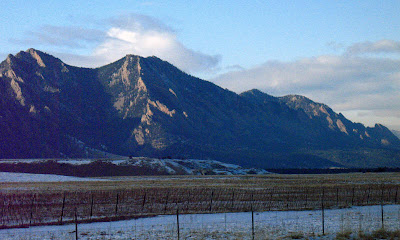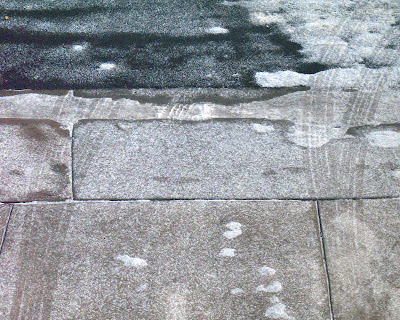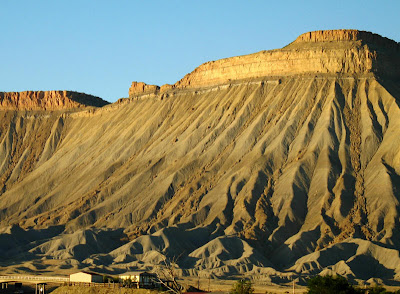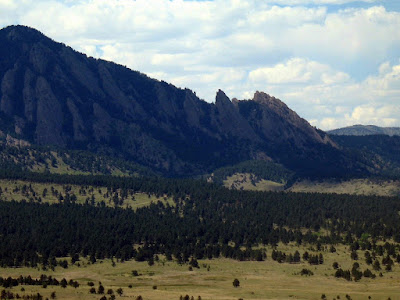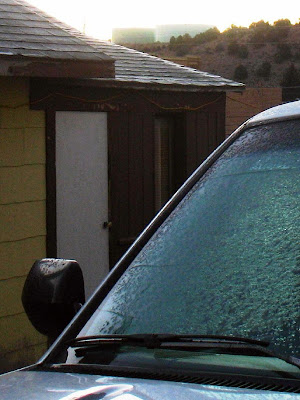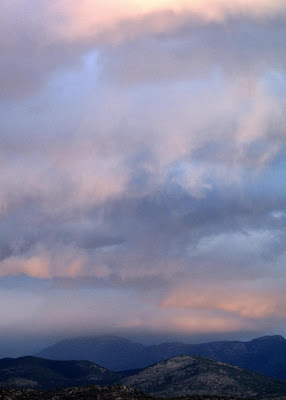Geotripper started
this geological 100 things meme - anyone, including non-geologists can play - and check out
Highly Allochthonous for the current score. Bold the ones you've done and add any notes, and put drop your link
here.
1.
See an erupting volcano [Pu'u O'o in Hawaii, 1987]
2.
See a glacier [several, several times, in Alaska]
3.
See an active geyser such as those in Yellowstone, New Zealand or the type locality of Iceland [Yellowstone]
4. Visit the Cretaceous/Tertiary (KT) Boundary. Possible locations include Gubbio, Italy, Stevns Klint, Denmark, the Red Deer River Valley near Drumheller, Alberta.
5.
Observe (from a safe distance) a river whose discharge is above bankful stage [a small wash or creek near Reno, Nevada, in flash flood]
6.
Explore a limestone cave. Try Carlsbad Caverns in New Mexico, Lehman Caves in Great Basin National Park, or the caves of Kentucky or TAG (Tennessee, Alabama, and Georgia) [I've mostly seen caves on tours - Lehman, Nevada, Carlsbad, N.M., and Luray in Virginia - I've also been in a cave now under water in the New Melones Dam area, California]
7.
Tour an open pit mine, such as those in Butte, Montana, Bingham Canyon, Utah, Summitville, Colorado, Globe or Morenci, Arizona, or Chuquicamata, Chile. [Several, including many of the big Carlin Trend mines in Nevada, Pinson, Nevada, a copper mine in Arizona, and the Mesquite and Picacho mines in California]
8.
Explore a subsurface mine. [A couple active U.G. mines, including the
Gooseberry mine in Nevada, and I've mapped several old, inactive mines]
9.
See an ophiolite, such as the ophiolite complex in Oman or the Troodos complex on the Island Cyprus (if on a budget, try the Coast Ranges or Klamath Mountains of California). [California]
10. An anorthosite complex, such as those in Labrador, the Adirondacks, and Niger (there's some anorthosite in southern California too).
11.
A slot canyon. Many of these amazing canyons are less than 3 feet wide and over 100 feet deep. They reside on the Colorado Plateau. Among the best are Antelope Canyon, Brimstone Canyon, Spooky Gulch and the Round Valley Draw.
12.
Varves, whether you see the type section in Sweden or examples elsewhere. [Pyramid Lake, Nevada and Summer Lake, Oregon - I think some of the Pleistocene lake deposits qualify as varves.]
13.
An exfoliation dome, such as those in the Sierra Nevada. [Half Dome, others]
14. A layered igneous intrusion, such as the Stillwater complex in Montana or the Skaergaard Complex in Eastern Greenland. [only in labs]
15.
Coastlines along the leading and trailing edge of a tectonic plate (check out The Dynamic Earth - The Story of Plate Tectonics - an excellent website). [the west coast of North America, especially Oregon and northern California, also Alaska; the east coast of the U.S., especially Virginia and Maine]
16.
A ginkgo tree, which is the lone survivor of an ancient group of softwoods that covered much of the Northern Hemisphere in the Mesozoic.
17. Living and
fossilized stromatolites (Glacier National Park is a great place to see fossil stromatolites, while Shark Bay in Australia is the place to see living ones). [fossilized ones, only]
18.
A field of glacial erratics. [British Columbia]
19.
A caldera [Crater Lake, Long Valley, Yellowstone, many old ones]
20.
A sand dune more than 200 feet high [Sand Mountain, Nevada, Imperial Sand Dunes, southern California]
21.
A fjord. [
Turnagain Arm and Knick Arm, Alaska]
22.
A recently formed fault scarp. [The
1954 Fairview Peak fault scarp in Nevada]
23.
A megabreccia. [Alaska, Nevada]
24.
An actively accreting river delta.
25.
A natural bridge. [
Natural Bridge, Virginia]
26.
A large sinkhole. [Somewhere near Austin, Texas]
27.
A glacial outwash plain. [Alaska]
28.
A sea stack. [Oregon coast]
29. A house-sized glacial erratic.
30. An underground lake or river.
31.
The continental divide. [
Loveland Pass]
32.
Fluorescent and phosphorescent minerals. [Smithsonian Museum of Natural History - and fluorescent ones under black light in core, in skarn, in labs]
33.
Petrified trees. [Petrified Forest National Park, Arizona]
34.
Lava tubes. [Subway Cave north of
Lassen Peak, California, Hawaii including one in action, and northern California]
35.
The Grand Canyon. All the way down. And back. [Rafted out]
36.
Meteor Crater, Arizona, also known as the Barringer Crater, to see an impact crater on a scale that is comprehensible. [I don't remember this very well, back in 1973]
37. The Great Barrier Reef, northeastern Australia, to see the largest coral reef in the world.
38. The Bay of Fundy, New Brunswick and Nova Scotia, Canada, to see the highest tides in the world (up to 16m).
39.
The Waterpocket Fold, Utah, to see well exposed folds on a massive scale. [A couple times, most recently in 1993]
40.
The Banded Iron Formation, Michigan, to better appreciate the air you breathe. [Marquette Iron Range, 1975]
41. The Snows of Kilimanjaro, Tanzania.
42. Lake Baikal, Siberia, to see the deepest lake in the world (1,620 m) with 20 percent of the Earth's fresh water.
43. Ayers Rock (known now by the Aboriginal name of Uluru), Australia. This inselberg of nearly vertical Precambrian strata is about 2.5 kilometers long and more than 350 meters high
44. Devil's Tower, northeastern Wyoming, to see a classic example of columnar jointing.
45. The Alps.
46.
Telescope Peak, in Death Valley National Park. From this spectacular summit you can look down onto the floor of Death Valley - 11,330 feet below. [I've seen the peak from Badwater and from Panamint Valley, but not from the top looking down]
47. The Li River, China, to see the fantastic tower karst that appears in much Chinese art
48. The Dalmation Coast of Croatia, to see the original Karst.
49. The Gorge of Bhagirathi, one of the sacred headwaters of the Ganges, in the Indian Himalayas, where the river flows from an ice tunnel beneath the Gangatori Glacier into a deep gorge.
50. The Goosenecks of the San Juan River, Utah, an impressive series of entrenched meanders.
51.
Shiprock, New Mexico, to see a large volcanic neck.
52. Land's End, Cornwall, Great Britain, for fractured granites that have feldspar crystals bigger than your fist.
53. Tierra del Fuego, Chile and Argentina, to see the Straights of Magellan and the southernmost tip of South America.
54.
Mount St. Helens, Washington, to see the results of recent explosive volcanism.
55. The Giant's Causeway and the Antrim Plateau, Northern Ireland, to see polygonally fractured basaltic flows.
56. The Great Rift Valley in Africa.
57. The Matterhorn, along the Swiss/Italian border, to see the classic "horn".
58. The Carolina Bays, along the Carolinian and Georgian coastal plain
59.
The Mima Mounds near Olympia, Washington. [I've seen these in several places, including northern Oregon]
60. Siccar Point, Berwickshire, Scotland, where James Hutton (the "father" of modern geology) observed the classic unconformity.
61.
The moving rocks of Racetrack Playa in Death Valley.
62.
Yosemite Valley. [Practically grew up there]
63. Landscape Arch (or Delicate Arch) in Utah.
64. The Burgess Shale in British Columbia.
65.
The Channeled Scablands of central Washington.
66.
Bryce Canyon.
67.
Grand Prismatic Spring at Yellowstone.
68. Monument Valley.
69.
The San Andreas fault.
70. The dinosaur footprints in La Rioja, Spain.
71. The volcanic landscapes of the Canary Islands.
72. The Pyrenees Mountains.
73. The Lime Caves at Karamea on the West Coast of New Zealand.
74.
Denali (an orogeny in progress).
75.
A catastrophic mass wasting event. [
Blackhawk slide in southern, California - huge; and the
Toutle River flooding and mudflow event following the 1980 Mt. St. Helens eruption]
76.
The giant crossbeds visible at Zion National Park.
77.
The black sand beaches in Hawaii (or the green sand-olivine beaches). [Maybe just the black sand beaches]
78. Barton Springs in Texas
79. Hells Canyon in Idaho.
80. The Black Canyon of the Gunnison in Colorado.
81. The Tunguska Impact site in Siberia.
82. Feel an earthquake with a magnitude greater than 5.0. [Not sure]
83.
Find dinosaur footprints in situ.
84.
Find a trilobite (or a dinosaur bone or any other fossil).
85.
Find gold, however small the flake. [Lots]
86. Find a meteorite fragment.
87. Experience a volcanic ashfall.
88.
Experience a sandstorm. [Mojave Desert, California]
89. See a tsunami.
90.
Witness a total solar eclipse. [1970]
91. Witness a tornado firsthand. [Only a very small one]
92. Witness a meteor storm, a term used to describe a particularly intense (1000+ per minute) meteor shower.
93. View Saturn and its moons through a respectable telescope.
94.
See the Aurora borealis, otherwise known as the northern lights. [As far north as Anchorage, as far south as Reno, Nevada]
95.
View a great naked-eye comet, an opportunity which occurs only a few times per century. [First in the late 1950's or early 1960's - not sure which one]
96.
See a lunar eclipse.
97. View a distant galaxy through a large telescope.
98. Experience a hurricane. [Only the spent portions of these]
99. See noctilucent clouds
100.
See the green flash.
That's 55, counting Telescope Peak from the bottom up, black sands for sure but maybe not green, and not hiking out of the Grand Canyon just all the way down. That's just about one per year. I probably won't make all of them, and there are a few I'd rather not experience except from a safe distance.
UPDATE: I just added #75, after reading
Geotripper's One Hundred; I've seen (and mapped part of) the Blackhawk slide in southern California, and was at the Toutle River while it was still in flood after the 1980 Mt. St. Helens eruption. That would make one per year.
 Posting and commenting has nearly fallen by the wayside while I sit and bask in the sun and clouds and wind of the Rocky Mountain Front Range. So far, I still haven't climbed up to the base of the giant Flatiron outcrops, not only because the visiting schedule here has been intense, or at least full, but also because I have caught one of those nasty holiday viruses. This one may have come all the way from Alaska, or maybe it came from Nevada, Utah, or Colorado! Hopefully it will be in retreat by the time I need to head back home.
Posting and commenting has nearly fallen by the wayside while I sit and bask in the sun and clouds and wind of the Rocky Mountain Front Range. So far, I still haven't climbed up to the base of the giant Flatiron outcrops, not only because the visiting schedule here has been intense, or at least full, but also because I have caught one of those nasty holiday viruses. This one may have come all the way from Alaska, or maybe it came from Nevada, Utah, or Colorado! Hopefully it will be in retreat by the time I need to head back home. I've had some nice relaxing times sitting by the tree and gazing out the window...
I've had some nice relaxing times sitting by the tree and gazing out the window... ...and have also gotten out and about a bit. The tree above was in the two-story lobby of the Hotel Boulderado, a fancy old European-style hotel and a great place to eat.
...and have also gotten out and about a bit. The tree above was in the two-story lobby of the Hotel Boulderado, a fancy old European-style hotel and a great place to eat.